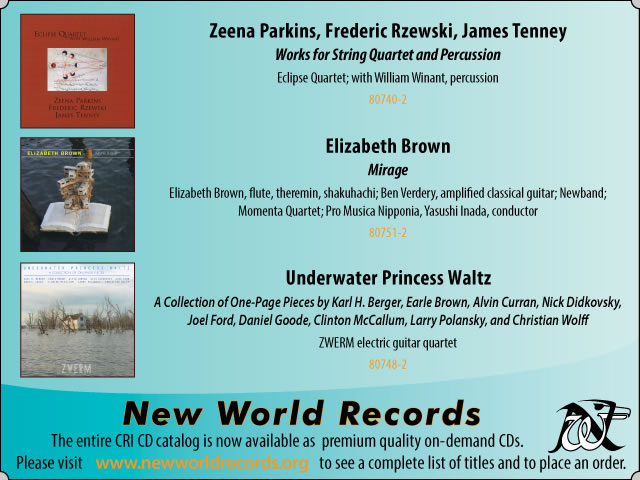Moment's Notice
Reviews of Recent Recordings
(continued)
Antoine Beuger
Cantor Quartets
Another Timbre at 62X2
Antoine Beuger + Jürg Frey
Dedalus
Potlatch 113
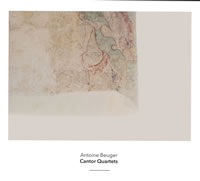
 Listeners of free improvisation are well accustomed to the exploration of silence and subtly resonant gesture in their music, and to some of the compositional lineages which has shaped music once called “reductionist.” Considerable attention has been given, these last few years, to the Wandelweiser collective, whose leading representatives include flautist Antoine Beuger, clarinetist Jürg Frey, and guitarist Michael Pisaro. In their compositions, these musicians have not only been unafraid to explore near total silence and the limits (audible and technical) of their instruments, they have also unreservedly embraced tonality in places and blended idioms (as with the regular use of vocals).
Listeners of free improvisation are well accustomed to the exploration of silence and subtly resonant gesture in their music, and to some of the compositional lineages which has shaped music once called “reductionist.” Considerable attention has been given, these last few years, to the Wandelweiser collective, whose leading representatives include flautist Antoine Beuger, clarinetist Jürg Frey, and guitarist Michael Pisaro. In their compositions, these musicians have not only been unafraid to explore near total silence and the limits (audible and technical) of their instruments, they have also unreservedly embraced tonality in places and blended idioms (as with the regular use of vocals).
Over two nights at Les Instants Chavires in April 2012, Dedalus finds Beuger and Frey joined by guitarist Didier Aschour, alto violist Cyprien Busolini, percussionist/vibraphonist Stephane Garin, and trombonist Thierry Madiot for three especially resonant performances. Beuger’s “Meditations Poetiques sur Quelque Chose d’Autre” might take the prize for title that best works as an aesthetic credo for these musicians, the whole approach seeming to take that term “autre” and run all the way with it to a music that slips the confines of just about everything. There are, here as elsewhere, multiple sounds that supplement, engage with, and unsettle the scored materials (melodic fragments, textual excerpts): pipe tones, creaking woods, and whispers. There are especially various car horns, but to my ears none of it gets in the way of the expertly controlled horn overtones, Aschour’s subtle guitar, or Garin deft navigation of space, with a rustle here and a thwack there. The entrance of the vibraphone and its melancholy figures gives a strange shape to those long, wafting held tones that suspend across each other in seeming infinity. Frey’s “Canones Incerti” trades in more audibly melodic material, with lovely, pinwheeling single tones pinging around with much space between them. Aschour is especially bright in the tonal thicket, and the piece moves marvelously alongside the vehicles audible outside the club as its intervals seem to chase down some chord progression. On “Lieux de Passages,” we hear a steady gathering cymbal clouds and muted, sculpted sound. Instruments stand out as naked and lyrical, nearly fragile in the sonic midst (though with lush, almost subliminal harmonization too). Things steadily sound as if they become decentered, the music somehow more multiple, with hints that it might burble over even as it returns repeatedly to a lush tonal thickness. It’s fabulous music overall, living in its thick gatherings of oscillations and resonance.
If there is a sometimes glassy quality to Dedalus, Beuger’s Cantor Quartets come across – despite a shared methodology of layering and lamination and extended silence – as more woolen. Beuger’s compositional instincts for timbre, resonation, and setting are audible on this two-disc set, documenting four pages of his lengthy 2003 composition. Recorded in an Oxfordshire church in Summer 2012, it features Frey (clarinet), Sarah Hughes (e-bow zither), Dominic Lash (bass), and Radu Malfatti (trombone). Unlike spare settings where each musician has a limited number of allotted notes per time period, or something, this one is about wellings up, dynamic arcs, and decay. It is very faint music, living in quiet oscillations, minor details that accrue significance as they make themselves known in their very suggestiveness and tendency to fade (a hint of tinnitus, a slowly lingering layer of which instruments one cannot tell, an audible fragment from a sonic painting of some sort). It takes its time in the first “page,” until at length there is an expansion, a deepening, as the music seems to find its own areas of tension, the layering now revealing semi-tones and half-tones between instruments (Malfatti’s low end is especially effective with Lash), and there is some tonal movement too. The second “page” resides in a space of more steady incandescence, with Hughes and Frey crucial in generating so many overtones. During the latter half of its forty minutes there are moments of real pause and suspension through intervals and differing oscillations, absolutely riveting stuff in the smallest of registers. The third “page” opens with a somewhat ragged low drone, mostly Lash for the opening sequences that concentrate in the lower and middle registers. There are long, but not achingly so, silences, an upwelling symphony of foghorns, and it’s particularly impressive how Beuger engages deliberately wrought timbral difference despite the continued presence of juxtaposition and overlap of instruments. There is also an unexpected and absolutely stunning sequence: a plane engine Doppler-ing away as high instruments join, forming a full tone field, as the piece entire just simply lifts in a single resonant chord. The final “page” retreats into almost total hush, with tiny particles in the upper register producing sine tone effects, super sinuous and restrained even compared to what’s come before. Following another unexpected event, the glorious foghorn chorus midway through, there is a long wind-down to an ominous thrum with deep resonance and spectral overtones. What bewitching music, almost like listening in to interstellar dust forming a proto-planet.
–Jason Bivins
Book of Three
Continuum (2012)
Relative Pitch RPR1012
The Convergence Quartet
Slow and Steady
No Business Records NBCD 53
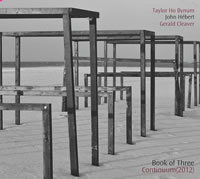
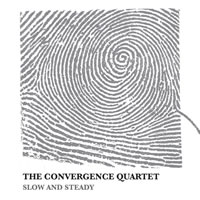 Cornetist Taylor Ho Bynum is perhaps known more “off the page” than on, for his work as an improviser and composer is paralleled by community activism, education and networking, especially in his current home of New Haven, Connecticut. Bynum is one of the key figures in the Tri-Centric Foundation, which seeks to spread the music and explore the thought-systems of Anthony Braxton as a way to spur creativity outside the immediate Braxton axis. Bynum has bicycled through Connecticut to play small arts venues, a free music embodiment of “thinking globally and acting locally.” Braxton and Bill Dixon, with whom Bynum also worked and studied, are and were staunch supporters of improvisers engaging local communities, to say nothing of their vast sonic influence. But the fact that these associations are so grand makes it easy to forget about Bynum’s own music, which is impressive and equally broad-minded.
Cornetist Taylor Ho Bynum is perhaps known more “off the page” than on, for his work as an improviser and composer is paralleled by community activism, education and networking, especially in his current home of New Haven, Connecticut. Bynum is one of the key figures in the Tri-Centric Foundation, which seeks to spread the music and explore the thought-systems of Anthony Braxton as a way to spur creativity outside the immediate Braxton axis. Bynum has bicycled through Connecticut to play small arts venues, a free music embodiment of “thinking globally and acting locally.” Braxton and Bill Dixon, with whom Bynum also worked and studied, are and were staunch supporters of improvisers engaging local communities, to say nothing of their vast sonic influence. But the fact that these associations are so grand makes it easy to forget about Bynum’s own music, which is impressive and equally broad-minded.
The Convergence Quartet is a transatlantic cooperative on their third discographical outing with Slow and Steady (previous discs were released by Clean Feed and FMR), recorded live at the Vortex in London. A brass-and-rhythm unit, in addition to Bynum the group features New York drummer Harris Eisenstadt, English pianist Alexander Hawkins and bassist Dominic Lash. Like other discs, Slow and Steady shares compositional duties across the quartet, and while their approaches differ the upshot is a blend of highly melodic voices. Eisenstadt combines rhythmic fluidity with pastoralism, while Hawkins draws from a diverse range of influences including Sun Ra, kwela and township music, Mary Lou Williams and Andrew Hill, and his improvisations are volcanic yet measured. Bynum’s lone composition of the date is “Remember Raoul,” a pensively behind-the-beat, yo-yoing piece that finds the cornetist in brittle muted mode as Hawkins grants pensive swirls to Lash’s motoring walk. The other players gradually fall away, slowing their time to whispered cries that shore up against filamented footfalls. By this point the piece has shifted into Lash’s “Piano Part Two,” brassy guffaws and skirling, metallic shouts clattering atop a dusky pedal point. Playful and particulate jaunts mark the pianist’s “equals / understand (totem),” Hawkins lushly skimming around the bar lines of a Monkish march as Bynum places fat, breathy daubs at phrases’ peaks and into skittering valleys. Slow and Steady is an assurance of the fact that occasional meetings between improvisers across great geographic distances can continually bear fruit, speaking to a broad sense of community and communication.
Perhaps more should be made of the fact that Bynum is a brass player who is entirely comfortable and perhaps even more forthright without another horn present (or at least a reedist) – not always an easy proposition to pull off. Book of Three pares the setting down even further to brass, contrabass (John Hébert) and drums (Gerald Cleaver), a format used effectively by Bill Dixon, Manfred Schoof and Raphé Malik. Building on an eponymous 2010 disc for Rogue Art, Continuum (2012) presents an arc of tradition from under-sung greats to contemporary group music, including tunes from the books of cornetist Bobby Bradford and Bostonian saxophonists Salim Washington and Jim Hobbs as well as members of the trio. Bradford’s “Comin’ On” is a powerful introduction to the set and explores a laconic, salty beat with Bynum pinching off Brownian motions into muscular abrasions; Hébert and Cleaver are well-matched and wonderfully captured, with the bassist’s throaty Henry Grimes-like pizzicato an interesting foil for Cleaver’s dry and airy particulars. Bynum brings forth a quiet confidence, able to disappear with almost scattershot phrasing, but with each cry and clamber bathed in an assertive diffusion. Though not entirely “Dixonian,” it is probably this particular approach that seems most rooted in Dixon’s music (not to mention the hallmark crumpled swallows). In other instances that might place the onus on the rhythm section’s strength, but as with the art of someone like Robert Ryman or Richard Tuttle, the conspicuousness and interest lies in great part with absence and delicacy, and how a player might shape something slight into an impactful object. Continuum (2012) features some truly extraordinary playing that, while economical, seems impossible to pass by.
–Clifford Allen
The Peter Brötzmann ‘Chicago Tentet’
Concert for Fukushima: Wels 2011
Trost TR114
Various Artists
Long Story Short: Wels 2011 Curated by Peter Brötzmann
Trost TR112
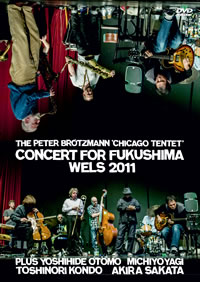
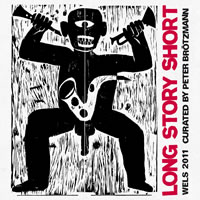 Remember Fukushima? It wasn’t that long ago, even if the nuclear disaster has receded further from the Western consciousness than the tide at the Bay of Fundy under a super moon. The Wels Unlimited Festival and Peter Brötzmann sought to make a rallying cry with the festival’s 2011 edition, engaging a host of Japanese improvisers to be part of the program’s mix of fixed and ad hoc ensembles. As Team Unlimited’s Wolfgang Wasserbauer states his Long Story Short booklet note, the festival originally wanted to present for its 25th edition “the total Brötzmann, the whole Brötzmann,” a demanding task to begin with. Roughly six months out, the decision to bring in the Japanese contingent required extraordinary logistical finesse. On the evidence of the DVD Concert for Fukushima: Wels 2011 and the 5-CD Long Story Short, the effort paid off handsomely, as not only the vitality and diversity of the Japanese improvised music community is reaffirmed, but their inclusion reinforces the under-articulated idea of Brötzmann as a global figure.
Remember Fukushima? It wasn’t that long ago, even if the nuclear disaster has receded further from the Western consciousness than the tide at the Bay of Fundy under a super moon. The Wels Unlimited Festival and Peter Brötzmann sought to make a rallying cry with the festival’s 2011 edition, engaging a host of Japanese improvisers to be part of the program’s mix of fixed and ad hoc ensembles. As Team Unlimited’s Wolfgang Wasserbauer states his Long Story Short booklet note, the festival originally wanted to present for its 25th edition “the total Brötzmann, the whole Brötzmann,” a demanding task to begin with. Roughly six months out, the decision to bring in the Japanese contingent required extraordinary logistical finesse. On the evidence of the DVD Concert for Fukushima: Wels 2011 and the 5-CD Long Story Short, the effort paid off handsomely, as not only the vitality and diversity of the Japanese improvised music community is reaffirmed, but their inclusion reinforces the under-articulated idea of Brötzmann as a global figure.
During a full-throttle performance by the Chicago Tentet included on the opening disc of Long Story Short, John Tchicai, whose singing was a natural extension – consequence, really – of his saxophone playing, turns the phrase “the task at hand” into a rallying cry. This sense of greater purpose informs and elevates the music throughout the collection; and it doesn’t always result in intensity measureable in megatons. For much of their lengthy exchange, Koto player Michiyo Yagi, cellist Okkyung Lee and guzheng player Xu Fengxia carefully layer gauzy textures. Guembri master Maâllem Mokhtar Gania and drummer Michael Zerang slow-cook an undulating groove, largely unperturbed by neither cellist/guitarist Fred Lonberg-Holm’s sandblasted textures nor Joe McPhee’s blazing alto saxophone. Masahiko Satoh’s piano solo is winsomely rhapsodic; the interplay between his springy ostinati and soaring right-hand lines sometimes evokes Abdullah Ibrahim and Randy Weston; but Satoh has his own distinctive attack and projection of velocity, as well as a seamless manner in developing materials.
Brötzmann has his relatively subdued moments as well. The collection-opening improvisation with Sonore, his trio with reedmen Mats Gustafsson and Ken Vandermark, has an initial spaciousness that’s not exactly light and airy, but still affords Brötzmann the elbow room to mull over a few choice phrases. He opens an ultimately blazing half-hour exchange with bassist Eric Revis and drummer Nasheet Waits with a soul-drenched dirge; in moments of eye-of-the-storm calm in longer, largely hard-hitting, if not atomizing blows like the nearly hour-long workout with Gania, bassist Bill Laswell and drummer Hamid Drake, Brötzmann creates engaging, rough-hewn melodies. Still, in the main, Brötzmann’s trademark intensity saturates the music, his cohorts soaking it up at every turn. There is something oddly gratifying in Brötzmann’s continued ability to throw flames, particularly in tandem with long-time associates like trumpeter Toshinori Kondo; just as was the case with Die Like a Dog, their rapport in Hairy Bones with bassist Massimo Pupillo and drummer Paal Nilssen-Love has a searing lucidity that separates them from any romanticized notion of two veterans on their most important campaign.
As strong as are most of the performances on Long Story Short, Concert for Fukushima is even more gripping. Kondo, Yagi, guitarist Yoshishide Otomo and saxophonist Akira Sakata join the Chicago Tentet for Brötzmann’s four-part “Japanese Landscapes.” Brötzmann’s visual art is largely predicated on a single gesture or image, be it the heroic implications of a single found piece of wood or the permutations of a fly swatter. Something of the same is at work with long form pieces like “Japanese Landscapes;” a motive or even a cry often being the extent of Brötzmann’s set materials, the cohesion and thrust of a piece is largely dependent on his cohorts’ responses. The Chicago Tentet knows and realizes his aims arguably better than any prior large ensemble Brötzmann has led. The contributions of the Japanese improvisers – particularly Sakata, one of the fiercest alto players on the planet – are no mere “guests;” instead, they are not just at the heart of the piece – they are the heart of the piece. Unfortunately, the camera work directed by Pavel Borodin is rather pedestrian; but that’s due to his being handcuffed by the layout of the theater, which forced the cameras to be placed in the back of the house. Still, this is music that needs to be heard, and not necessarily seen – a powerful reminder of the reality that will prevail for millions of Japanese for the duration.
–Bill Shoemaker
John Butcher + Thomas Lehn + John Tilbury
Exta
Fataka 7
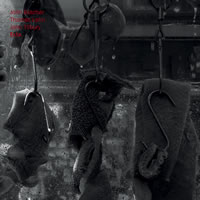 The notes for this CD provide an explanation of the title: “In ancient Roman religious ritual, exta were the organs of a sacrificed animal that were offered up to the gods – the lungs, heart, liver and gall bladder; here, Exta is a selection of four pieces (one in two parts) carefully extracted from a long studio session.” The five segments bear Latin names, “Pulmo” (Lungs) comes in two parts and they bracket “Cor” (heart). The other pieces are “Lecur” (liver) and “Fel” (gall bladder).
The notes for this CD provide an explanation of the title: “In ancient Roman religious ritual, exta were the organs of a sacrificed animal that were offered up to the gods – the lungs, heart, liver and gall bladder; here, Exta is a selection of four pieces (one in two parts) carefully extracted from a long studio session.” The five segments bear Latin names, “Pulmo” (Lungs) comes in two parts and they bracket “Cor” (heart). The other pieces are “Lecur” (liver) and “Fel” (gall bladder).
It’s a neat and multidimensional metaphor for the processes of improvisation and editing, creation and selection, resonating with both the unconscious and the wily evasions that might find offal the appropriate food for unseen gods. I suspect that nicely turned bit of linguistic arcana – from the horse’s mouth, so to speak – might be the most incisive writing this performance can receive. It points to the fundamental mystery of improvisation such as this – a work that operates on largely unknown principles and which is offered up to assume meaning in its reception.
That sense of offering is in keeping with the processes at work in the music. Each aspect is both discrete and continuous, likely to become silent and as liable to reappear. There’s a keen sense of identification between John Butcher’s saxophone and Thomas Lehn’s synthesizer, a sonic concordance so strong that at times only Butcher’s decays reveal the horn. On the long “Lecur,” devoted for great lengths to Tilbury’s transcendent piano reverie, it may be largely the presence of air and a sudden squawk that distinguish Butcher’s materials from Lehn, who is sometimes present almost environmentally, as another consciousness vibrating in the space. By the segment’s conclusion, a Messiaen-ic bird world, the attempt to distinguish voices seems misplaced, an affront to the music’s unity, as if the slaughtered animal becomes whole in the ritual.
Those various organ meats might find further resonance in the different kinds of reverberation here, from the echoing sustain of Tilbury’s piano, Lehn’s continuous electronics, or Butcher’s circular breathing. As in ritual, it’s music in which the silences – occasional pauses and those silences contributed by whomever is not playing or is playing to the minimal degree to assert presence – are a potent part of what is heard. These are masters at work, three sages in a butcher shop, decorating an altar of silence with sound.
–Stuart Broomer
John Carter & Bobby Bradford Quartet
Flight for Four
International Phonograph, Inc. FDS-108
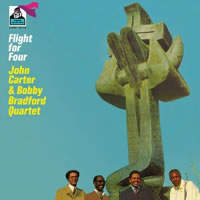 Two of the most important figures to emerge during the post-war years from the tight-knit, relatively obscure West Coast free jazz scene, multi-instrumentalist John Carter and trumpet player Bobby Bradford formed a legendary partnership now widely considered to be one of the most fruitful and rewarding in modern jazz. Accentuating each other’s strengths with virtually telepathic sensitivity, Carter’s fervent formalism and strident precision was gracefully offset by Bradford’s lyrical restraint and timbral subtlety, yielding a rich multihued rapport. Shortly after meeting in 1967, they started a quartet with bassist Tom Williamson and drummer Bruz Freeman called the New Art Jazz Ensemble that ultimately produced a small number of prized LPs.
Two of the most important figures to emerge during the post-war years from the tight-knit, relatively obscure West Coast free jazz scene, multi-instrumentalist John Carter and trumpet player Bobby Bradford formed a legendary partnership now widely considered to be one of the most fruitful and rewarding in modern jazz. Accentuating each other’s strengths with virtually telepathic sensitivity, Carter’s fervent formalism and strident precision was gracefully offset by Bradford’s lyrical restraint and timbral subtlety, yielding a rich multihued rapport. Shortly after meeting in 1967, they started a quartet with bassist Tom Williamson and drummer Bruz Freeman called the New Art Jazz Ensemble that ultimately produced a small number of prized LPs.
The Ensemble’s first album, Seeking, was cut for the tiny independent Revelation Records, while the second, Flight for Four, was recorded on April 1, 1969, four months later. Issued on CD for the first time ever in an elegant limited edition pressing by International Phonograph, Flight for Four is a seminal document of the West Coast avant-garde. Originally released by Flying Dutchman Records, label founder and former Impulse! Records producer Bob Thiele convinced the band to change their name to the John Carter & Bobby Bradford Quartet for their sophomore effort, ostensibly for marketing reasons.
Although the name New Art Jazz Ensemble implied a collective sensibility, the majority of the band’s material was written by Carter, whose nascent compositional approach was still heavily influenced by the harmonically unfettered concepts pioneered years earlier by Ornette Coleman. Such similarities are not unexpected however, as Carter and Coleman both grew up in Forth Worth, Texas playing bebop together as teenagers in the 1940s. In addition to developing compatible music theories, Coleman introduced Carter to Bradford, whose role as Coleman’s original foil (Don Cherry took the trumpet chair after Bradford was drafted into the military in 1954) reinforced the aesthetic commonalities between Carter and Coleman’s writing styles.
Even though Carter would ultimately choose to play Bb clarinet exclusively, at this early stage in his career he primarily played alto and tenor saxophone; on this recording, his sinuous clarinet ruminations are heard only on the haunting ballad “Woman,” Bradford’s sole compositional contribution to the date. Carter’s eventual decision to abandon the saxophone in the early 1970s was met with some trepidation by his frontline partner, who said “I was not making happy noises about him leaving the alto. I loved his saxophone playing.” Bradford’s disappointment is understandable upon further reexamination; Carter’s acerbic flights (particularly on alto) are breathtaking in their exuberance, especially on the spirited “Call To The Festival” and “The Second Set,” where his circuitous cadences spiral into increasingly taut, dramatic arcs, punctuated by furious chromatic trills and climactic split tones.
Providing melodious counterpoint to Carter’s vigorous extrapolations, Bradford’s enigmatic phrasing already sounds fully realized, his bop credentials providing a solid foundation for his oblique harmonic variations and evocative abstractions, which range from half-valve flurries to elongated brassy smears. His plangent thematic motifs on “Abstractions For Three Lovers,” the record’s most sophisticated tune, perfectly underscore the impressionistic piece’s moody ambience. Conversely, he keeps apace with Carter’s turbulent tenor salvos on the blistering closer “Domino,” eliciting a quicksilver series of breathy extemporizations on the angular theme.
The rhythm section alternates between swinging, in-the-pocket grooves and freewheeling interplay, with Williamson typically providing a steady bass pulse, while Freeman excels at playing propulsive rhythms unconstrained by rigid time signatures. Bradford has maintained in interviews that Freeman was one of the first “free drummers.” His claim is well supported by Freeman’s performance on the opening cut, “Call To The Festival,” where he provides a strong, driving pulse that constantly changes tempo, as well as on the rubato meditation “Abstractions For Three Lovers,” which features the dynamic ebb and flow of his cymbal accents and brush work in tandem with Williamson’s arco.
The quartet eventually recorded and released Self Determination Music for Flying Dutchman in 1970, but by 1972 the original lineup had disbanded, with only Freeman appearing as a member of the rhythm section on one cut from that year’s Secrets (Revelation). Carter and Bradford continued to work together throughout the ensuing years; in addition to Carter’s overlooked 1979 Variations on Selected Themes for Jazz Quintet (Moers) and the 1982 duo sessions Tandem 1 and Tandem 2 (Emanem), their partnership culminated with Carter’s magnum opus, the ambitious five album series Roots and Folklore: Episodes in the Development of American Folk Music.
–Troy Collins
